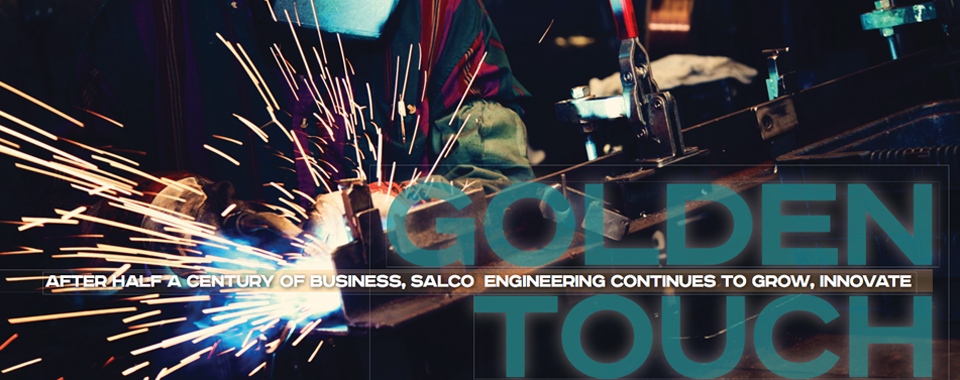Innovation. Integrity. Longevity. These cornerstones have not only helped Salco Engineering and Manufacturing Co. survive for half a century, they’ve helped it thrive.
Salco, founded in 1963, designs and manufactures components for material handling systems, including baskets and inserts, carts and racks for bakery, automotive, medical and industrial clients. Their systems contain everything from gear parts used in auto assembly lines to loaves of bread stored on racks.
“We’re proud of our longevity,” said Salco President Jim Flack, who sat down for an interview in an upstairs office. “A big reason for that is our emphasis on innovation. We’re always trying to stay one step ahead.”
3-D Innovation
Near his office was the proof of his statement: a 3-D printer that looked a like a vending machine, complete with a glass window. Except in this case, the window didn’t display soft drinks or snacks but moving robotic parts laying down thin layers of plastic, one on top of the next, creating a 3-dimensional object based on computer aided design (CAD) data.
“This 3-D printer allows us to create prototypes quickly and inexpensively. That, in turn, helps us catch design flaws before the product is manufactured,” said Project Manager Chris Gancsos.
Before Salco purchased the 3-D printer in February, full-size workable prototypes were built by company employees, meaning, if a mistake was found with the design, it was an “expensive mistake,” said Gancsos, who has a bachelor’s degree in biosystems engineering from Michigan State University.
But it’s a different ballgame now. “This printer saves Salco substantial time and money compared to traditional prototyping and allows for quick turnaround,” Gancsos said, adding that simple prototypes can be made in hours.
Reverse Engineering
Designing components for material handling systems requires a considerable amount of creative thinking and the ability to go from the known to the unknown, said Flack.
“Our clients tell us what products they want to contain or move,” such as a 2-foot long gear shaft, said Flack. “They may say it needs to be held in an upright position while on an assembly line or conveyor. Then we design and manufacture a support system to accomplish that.”
Flack’s son and Salco Estimator David Flack calls the creative process “reverse engineering.” “We start with the known— the size, weight and composition of the customer’s product. Then we work backwards to the unknown—creating an entirely new holding feature that presents or contains the product in a specified way,” he said.
Automotive clients want wire baskets precisely engineered so that robotic arms can easily reach into them and pick up a small part as the basket moves along an assembly line. “Most of what we do is custom work; it has to be precisely configured to clients’ unique needs, down to the millimeter,” said CAD Operator David Lewis, who has an associate’s degree in computer aided design from Baker College.
The process involves not only precision but also “out-of-the-box” thinking, said Gancsos. “That’s one of the things I love about working here. We don’t just pump out widgets. We do design work. Everything is custom.”
From Designs to Finished Products
As employees described the designing process in the upstairs office, Plant Manager Rich Harbaugh worked on the fabricating end of the business one floor below, using a plasma torch to cut holes in a steel sheet destined to be the shelf of a cart. Plasma torches heat gas by electrical means to form a high temperature substance—plasma—that is capable of cutting through steel.
“This is where we turn the designs into finished products,” said Harbaugh, standing on the ground floor filled with resistant welders, press breaks and wire straighteners, to name a few machines. “But I also do just about anything that needs to be done, including mowing the grass,” said Harbaugh, who has worked at Salco for 29 years.
In the welding area below, two employees wearing patriotic red, white and blue helmets welded casters on frames for a bakery dolly, sending out a spray of sparks that looked like mini fireworks.
Around the corner, Head Welder Mark Myers fabricated a steel sheet for a special cart to carry pallets. “I like working here,” said Myers, a 27-year Salco veteran. “In fact, I’ve been with these guys so long, they’re like a second family.”
Small Business with Big Impact
While Salco, which employs 11, may be classified as a “small business,” it has a big impact throughout Michigan and the world. Clients range from the Big Three automakers to individuals who want to create prototypes using the 3-D printer. “Most places with 3-D printers only use them in-house, but we’ll quote 3-D printing services for outside business or individuals,” said Gancsos.
About 90 percent of Salco’s orders are shipped domestically—to all 50 states. The other 10 percent are shipped internationally, to countries such as Germany, Poland, Canada and Mexico, Flack said. Jackson comprises a slim margin of Salco’s business. “A lot of Jackson residents don’t even know we exist,” laughed Flack, referring to the large, red two-story building south of the Armory Arts Village.
But not only does it exist, this year marks a half century of providing customers’ material handling needs. The milestone is all the more significant because the United States lost one third of its manufacturing jobs—or 5.73 million—in the last decade, according to Business News Daily, an online business news source (www.businessnewsdaily.com).
“Jackson is very fortunate to have a company like Salco Engineering and a leader like Jim Flack. Small companies can make a big impact and Salco is an example of that, providing quality jobs for 50 years. That’s an accomplishment worth celebrating,” said Mindy Bradish-Orta, president of the Jackson County Chamber of Commerce.
“We’ve survived a lot of ups and downs. I’m proud we’re still here—and moving forward,” said Flack, adding that Salco has increased its output substantially in the last three years because of its advancements in technology as well as the general improvement of the global economy.
“When I started, my dad and I made the commitment to implement more advanced technology into Salco’s daily procedures,” said David Flack. “Everything from the 3D printer to new computers to Solidworks (CAD) software are improvements that allow Salco to compete with much larger companies in the material handling industry.”
The Beginnings
Global outreach was not among services when Bob Currier, Harold Bussing and Walt Mitchner founded the business in 1963 (All are now deceased). Salco, named after a combination of the words “sale” and “company,” originally made shelving bins for nationwide K-Mart stores and provided repair work on various steel products for Michigan-based companies, Flack said.
The company’s reputation for hard work, living within its means, honesty and personal rapport with customers served it well throughout the ebb and flow of economic vacillations, and ultimately enabled the local material supplier to expand its market around the world, said Jim Flack, who joined Salco in 1979, after working as a teacher for the Pontiac School District.
Flack, a 1970 graduate of Parkside High School, earned a bachelor’s degree from Albion College in 1974, and worked in various departments at Salco from assembly to sales to management. He was appointed president in 2002. Son David joined Salco in 2009 after graduating from Albion College with a bachelor’s degree in economics and management.
“David has brought a lot of new ideas to the table,” said Jim. “I’ve learned from some of the technological innovations he’s brought. And he’s learned some of the tried and true ways of handling the job and interacting with customers from me. It’s a good combination.”
David agreed: “This has been a learning process that has required a lot of patience and understanding from both of us. We’ve made good choices to keep Salco competitive.”



